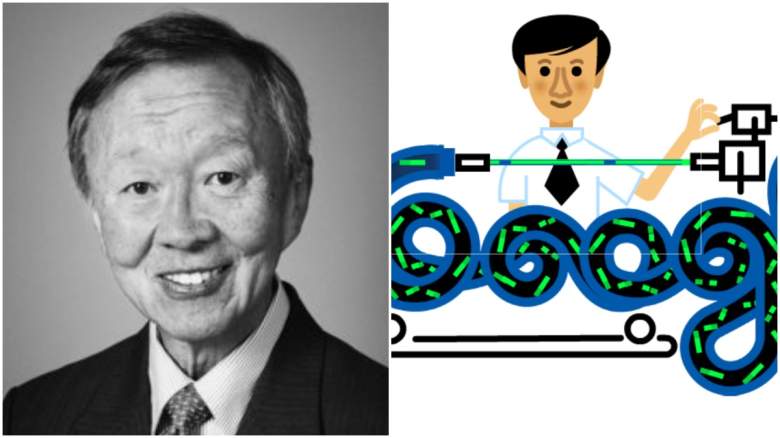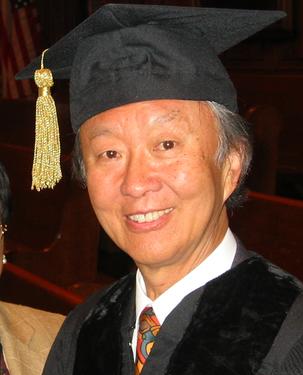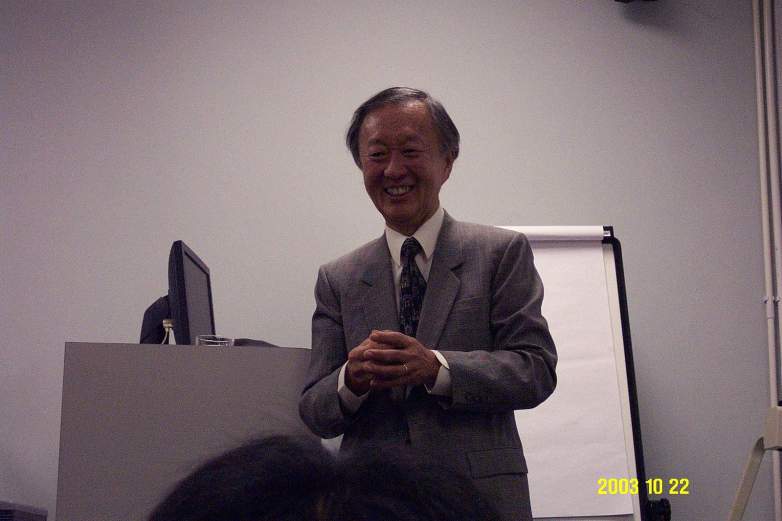
Wikimedia Commons/Google Charles K. kao
Charles K. Kao was a “visionary Chinese-born, British-American physicist and educator” whose invention changed how society communicates. He is honored with a Google Doodle on November 4, 2021.
Kao was “considered the father of fiber optics whose innovations revolutionized global communication and laid the groundwork for today’s high-speed internet,” reports Google.
November 4, 2021, is Kao’s 88th Birthday. He died on September 23, 2018. “The word ‘visionary’ is overused, but I think in the case of Charles Kao, it’s entirely appropriate because he really did see a world that was connected, by light, using the medium of optical fiber,” said John Dudley, a researcher in fiber optics, to the New York Times. “And I think society today owes him a great deal for that work.”
Here’s what you need to know:
1. Kao Was Born in Shanghai to a Wealthy, Accomplished Family

Nobel PrizeKao with his family (he’s in the front as a child)
According to Google, Charles Kuen Kao “was born on this day in 1933 in Shanghai, China.”
The Nobel Prize website includes a biography by Kao that says the Kao family “comes from a township called Zhangyan in the Jinshan district near Shanghai, China1.”
They were concerned wealthy landowners, and the sons were to be educated well. His grandfather was named Kao Hsieh2. “He was a literary man, famous for his beautiful poems, which he would render in Chinese calligraphy,” the Nobel Prize website says.
“As a Confucian scholar, he was a collector of books and also a prominent member of the Nan She (Southern Society). Other family members were also active in the Society; its aim during the 1911 Chinese Revolution was to help bring down the ruling Qing dynasty.”
His grandfather had six children, including Kao’s father, Kao Chun Hsin. The third son, his father studied at Michigan Law School and was involved in an arranged marriage to a poet. He returned from Michigan and was named a Chinese judge, moving his family to Shanghai, the site’s biography says.
Kao and his brother were born after their parents lost other children to illness and miscarriage. Kao said he and his brother lived a “pampered life.” He wrote, “Nursemaids kept constant watch. With my parents busy at dinner parties and social events, we only met them as if for a daily royal audience.”
2. Kao, Who Studied Electrical Engineering in England, Was Considered a ‘Pioneer’

Wikimedia CommonsCharles Kao
“Drawn to intellectual work early in life with notable academic success, he went on to study electrical engineering in England,” Google reports. “He supported his graduate studies as an engineer at Standard Telephones and Cables Ltd., where his colleagues invented the laser in 1960.”
Charles Kao was “the pioneer who suggested using glass fibre waveguide as a means of carrying laser-light over long distances for telecommunications traffic,” reports Royal Society Publishing.
In a paper in 1966, “he spelled out the appropriate design parameters and performance characteristics that would be needed for a successful system to emerge.:
The idea was “widely ridiculed” at first, but later became accepted information. “…optical fibres now dominate telecommunications worldwide. Without them, contemporary communications would be unthinkable,” explains Royal Society Publishing of Kao’s contribution.
3. Kao Won the Nobel Prize

Wikimedia CommonsCharles Kao
Britannica describes Kao as a physicist “who was awarded the Nobel Prize for Physics in 2009 for his discovery of how light can be transmitted through fibre-optic cables.”
According to the site, he “shared the prize with physicists Willard Boyle and George E. Smith, who won for their work in inventing the charge-coupled device (CCD).”
He was a citizen of both the U.S. and Great Britain, the site reports.
4. Kao Had Two Children With His Wife, Who Live in California
According to the Royal Society Publishing biography, Kao met a woman named Gwen who was “from a British Chinese family” and was also called May Wan Wong. She became his “constant companion” until his death.
They were married in 1959 and had two children, who live in California, the site reports.
Kao died in 2018.
5. Kao’s Invention ‘Transformed the Way the Human Race Communicated’
According to Royal Society Publishing, Kao’s “‘crazy 1966 vision’ of a single-mode optical fibre had truly transformed the way that the human race communicated, both locally and globally, honours and awards started to shower upon him.
In an obituary when he died in Hong Kong at age 84, The New York Times reported that Kao “helped lay the technical groundwork for the information age.”
Google noted, “Kao’s landmark research in the 1960s earned him a joint Nobel Prize in Physics in 2009 and cleared the path for the over 900 million miles of fiber-optic cables that carry massive quantities of data across the globe today.”
READ NEXT: Radio Exec ‘Paddy Duke’ Fired After Past Accusations Of Murder Exposed